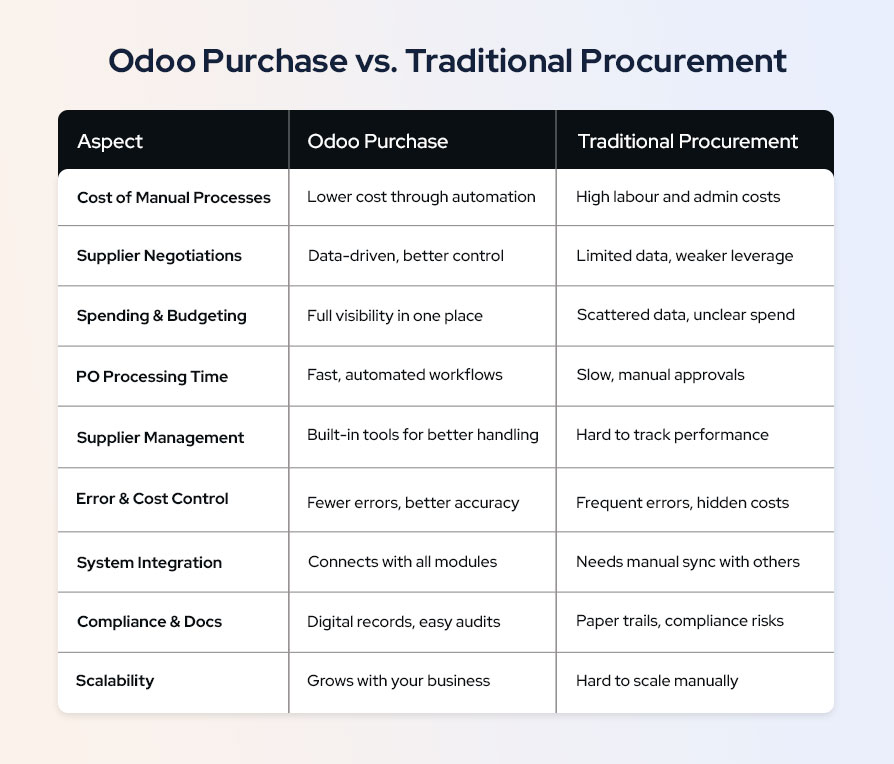Procurement is one of the biggest cost centres for any business. Managing suppliers, negotiating contracts, tracking orders, and ensuring timely deliveries can become a complex and expensive process. Many businesses still rely on traditional procurement methods, which involve spreadsheets, emails, and manual follow-ups. But as competition grows and profit margins tighten, companies are looking for smarter, more efficient ways to control procurement costs.
This is where Odoo Purchase offers a modern, automated alternative. The points below shared by an expert consultant of Odoo in Australia, break down how Odoo Purchase compares to traditional procurement and which approach saves businesses more money while increasing efficiency.
Odoo Purchase vs. Traditional Procurement

Cost of Manual Processes vs. Automated Procurement:
Traditional procurement depends heavily on manual tasks. Purchase orders are created manually, approvals happen over emails, and supplier follow-ups require phone calls or spreadsheets. Every step takes time, and time is money. When employees spend hours chasing approvals or correcting order errors, productivity drops, and operational costs rise.
Odoo Purchase eliminates these inefficiencies. The system automates purchase order creation, approval workflows, and supplier communications. Instead of relying on back-and-forth emails, purchase requests can be approved within seconds based on pre-set rules. This automation reduces human effort, prevents errors, and speeds up procurement cycles, ultimately cutting down costs.
Supplier Negotiations and Cost Control:
Businesses that stick to traditional procurement often lack the insights needed for effective negotiations. Without proper data, procurement teams struggle to get the best prices from suppliers. Comparing past purchase records, tracking supplier performance, and identifying cost-saving opportunities require hours of manual effort.
Odoo Purchase provides real-time data on supplier pricing, order history, and performance. With built-in reporting, businesses can compare quotations instantly, identify the most cost-effective vendors, and even automate supplier selection. Bulk purchasing and early payment discounts are easier to manage, helping businesses secure better deals and reduce procurement expenses.
Visibility into Spending and Budgeting:
A common challenge with traditional procurement is the lack of spending visibility. Many businesses rely on outdated spreadsheets or disconnected systems, making it difficult to track procurement costs accurately. Overspending, duplicate purchases, and budget mismanagement are frequent issues.
With Odoo Purchase, businesses gain complete visibility over their spending. Every purchase request, approval, and order is recorded in one place. Managers can set budget limits, monitor expenditures in real time, and receive alerts for any unexpected cost increases. This level of control prevents financial leaks and ensures smarter procurement decisions.
Purchase Order Processing Time:
Traditional procurement can be slow, with purchase order approvals taking days due to manual approvals and miscommunication. Delays in processing orders can lead to stock shortages, production halts, and missed business opportunities.
Odoo Purchase accelerates the entire process. Automated approval workflows, real-time tracking, and digital documentation ensure that purchase orders are processed within minutes, not days. Faster procurement means better inventory availability, uninterrupted operations, and happier customers.
Handling Supplier Relationships Efficiently:
Maintaining good relationships with suppliers is crucial for long-term cost savings. Traditional procurement methods make it difficult to track supplier performance, delivery timelines, and pricing trends. Poor visibility often results in missed opportunities for better contracts.
Odoo Purchase centralises supplier management. Businesses can monitor supplier performance, track delivery times, and manage contracts more effectively. If a vendor consistently delays shipments or increases prices, procurement teams can quickly adjust their strategies. Stronger supplier relationships lead to better deals and more reliable deliveries.
Reducing Errors and Avoiding Extra Costs:
Human errors in procurement can be expensive. Misplaced orders, incorrect invoices, or duplicate purchases often result in financial losses. Traditional procurement methods increase the chances of such mistakes, especially when relying on manual data entry.
Odoo Purchase minimises errors through automation. Purchase orders, invoices, and receipts are linked within the system, ensuring accuracy at every stage. Automatic matching of invoices with purchase orders prevents overpayments and financial discrepancies. Businesses save money by avoiding unnecessary expenses caused by errors.
Seamless Integration with Other Business Functions:
Traditional procurement often operates in isolation. Purchasing data is stored separately from inventory, accounting, or sales, making it difficult to align procurement with overall business needs. Delays in communication between departments lead to stock shortages, excess inventory, or cash flow issues.
Odoo Purchase integrates seamlessly with inventory, accounting, and sales. If stock levels drop, purchase orders can be triggered automatically. Accounts payable teams can process supplier invoices without delays. This interconnected approach improves efficiency, prevents stock-outs, and optimises working capital.
Compliance and Document Management:
Regulatory compliance and document tracking are major concerns in procurement. Traditional methods require businesses to maintain paper records or scattered digital files, increasing the risk of missing important documents during audits.
Odoo Purchase simplifies compliance. Digital records of purchase orders, invoices, and supplier contracts are securely stored and easily accessible. Automated compliance tracking ensures that businesses meet legal requirements without extra administrative work.
Scalability for Growing Businesses:
As businesses expand, procurement becomes more complex. More suppliers, higher purchase volumes, and increased paperwork make traditional procurement unsustainable in the long run.
Odoo Purchase is built for scalability. Whether a business manages a few or thousands of purchase transactions, the system adapts without increasing administrative workload. Automated workflows, centralised data, and real-time reporting ensure that procurement remains efficient as the company grows.
Which Approach Saves More?
The financial impact of procurement inefficiencies cannot be ignored. Traditional procurement leads to hidden costs – delays, errors, missed discounts, and poor supplier management—all of which reduce profitability. On the other hand, Odoo Purchase streamlines the entire procurement cycle, reducing administrative overheads, improving supplier negotiations, and providing real-time cost control.
Businesses that switch to Odoo Purchase often see immediate cost savings, faster processing times, and stronger supplier relationships. In a competitive market, optimising procurement isn’t just about reducing costs – it is about staying ahead.
Want to improve your procurement strategy and cut unnecessary expenses? Innumerable users trust Envertis, the top partner of Odoo in Australia, for expert Odoo implementation, helping businesses achieve smarter, cost-effective purchasing. Contact us today and take control of your procurement costs.


